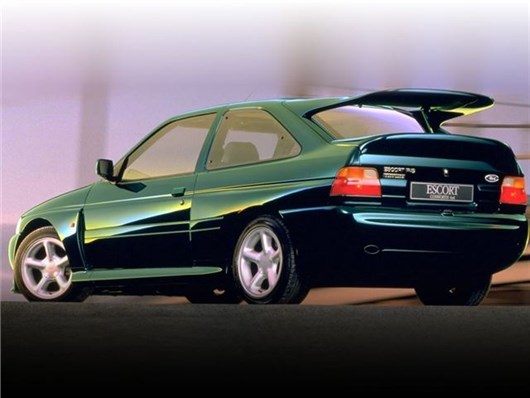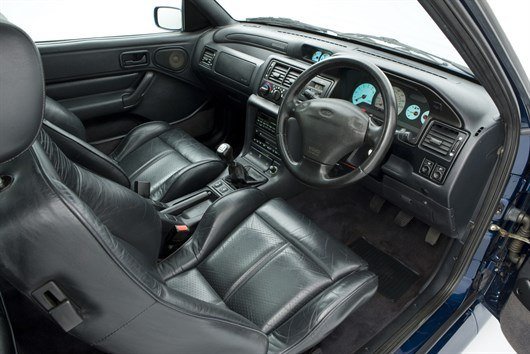Happy Birthday: Ford Escort RS Cosworth

If Ford’s 1980s motorsport campaign was all about saloon car racing, with which the legendary Sierra Cosworth first found fame, then its aim for the 1990s was to take the World Rally Championship by storm.
Its first attempt came in the shape of the Ford Sierra Sapphire Cosworth 4x4, which enjoyed moderate success in Group A rallying, but it was with the Escort RS Cosworth that Ford would once again prove the Escort’s name in rallying, harking back to the glory days of the rear-drive Mk1s and Mk2s that dominated the scene throughout the 1970s.
Developed in a similar vein to the Lancia Integrale and Subaru Impreza, the Escort Cosworth was a Group A rally car for the road. It arrived in showrooms in late January 1992, an astonishing 25 years ago, though its story begins three years earlier, with Ford’s Special Vehicle Operations (SVO) designing the Cosworth’s outrageous bodywork two years before the car on which it was based would even see the light of day.
The Mk5 Escort on which the Cosworth was based was mediocre at best. Neatly, if conservatively, styled it was mechanically old-fashioned and driving it was drudgery thanks to a crashy ride and lifeless steering. In lower trim levels, with Ford’s awful CVH engine, it was a fairly miserable beast. The Escort RS Cosworth, on the other hand, couldn’t have been more different.

But then again, it wasn’t, technically, an Escort. Underneath, the all-wheel-drive platform was actually that of a truncated Sierra RS Cosworth, with 260mm hacked out the middle, a shortened propshaft and a Haldex diff. Power came from the same 2.0-litre turbocharged longitudinally-mounted Cosworth-developed engine.
The lairy exterior was largely the work of Stephen Harper, as his first major job for Ford. Based at Ford’s SVO headquarters in Borehamwood, Herts, Harper had previously worked for Austin-Rover, where he had led the exterior styling of the Rover 800 Fastback and Austin Montego estate projects. His stint at Ford would be a short one, the Escort Cosworth his only design, before heading off to set up his own company, SHADO Ltd (Stephen Harper Automotive Design Organisation), where he would work on a contract basis as chief exterior designer for Rover Group’s MGF and the LTI London Taxi.
But Harper’s one Ford design would also become one of the Blue Oval’s more iconic, not least because outside of motorsport, the Escort Cosworth would become a desirable car in its own right. It was never built on a Ford production line, with the initial batch of prototypes being hand-built at SVO and then series production by coachbuilders, Karmann, in Germany.
At launch, two models were available, the Club-spec standard car at £21,380 and the Lux version, which included electric windows, heated screen, sunroof, and leather Recaro seats. Power was up slightly from the Sierra RS Cosworth at 227bhp, while the lighter bodywork also helped the Escort enjoy superior performance, with 0-62mph possible in 5.7 seconds, and a top speed limited to 150mph.

The first 2500 cars, built up to May 1994, were "homologation specials" used to get FIA accreditation for entry into the World Rally Championship. They were fitted with a Garrett T3/T04B turbocharger and suffered from horrific turbo lag. Among the initial build, a handful were badged as Motorsport versions, these lacked certain refinements such as a sunroof and sound deadening.
From a driveability perspective, the remaining 4,500 of the 7,000 production run were improved thanks to their smaller Garrett T25 Turbo. In 1995, the RS Cosworth was treated to a mild facelift where it received a new honeycomb grille, restyled bumpers, a more attractive fascia and revised alloy wheels, and in terms of road appeal these are arguably the best, though the least classic of the lot.
In the rallying stakes, the Escort Cosworth never quite achieved the success that Ford had hoped for, despite it being something of a 1990s rallying icon. It took 10 WRC victories overall; the first in the 1993 Portuguese Rally with Francois Delecour at the wheel and the last in the 1997 Rally of Indonesia in the hands of Carlos Sainz. But despite these victories, it was never the overall WRC champion, losing out to Lancia, Subaru and Toyota during its rally career.
Eventually, it was emissions regulations that forced the Escort Cosworth out of production, well before demand had dwindled. It was almost exactly four years to the day since it first appeared, which was 25 years ago this week. It was a classic when launched, but quarter of a century on is now even more of an icon – raise your glasses to the champion that never was…
Comments
Compare classic car insurance quotes and buy online. A friendly service offering access to a range of policies and benefits.


 Craig Cheetham
Craig Cheetham
 NEC classic motor show 2020 postponed due to Covid 19 concerns
NEC classic motor show 2020 postponed due to Covid 19 concerns
 Classic car auction house Coys goes into administration
Classic car auction house Coys goes into administration
 Motor racing great Sir Stirling Moss dies aged 90
Motor racing great Sir Stirling Moss dies aged 90
 Alfa Romeo anniversary races set for Silverstone
Alfa Romeo anniversary races set for Silverstone
 Government to make E5 fuel available for classic owners
Government to make E5 fuel available for classic owners
 Plans to introduce cleaner fuel could damage more than a million classic cars
Plans to introduce cleaner fuel could damage more than a million classic cars
 Top 10: Classic cars from the Gulf motor racing heritage collection
Top 10: Classic cars from the Gulf motor racing heritage collection











Add a comment